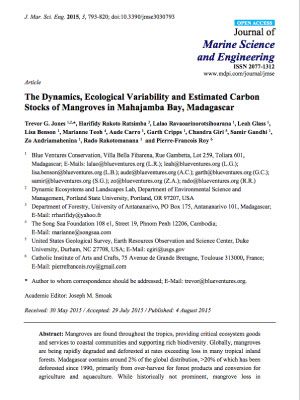Abstract
Mangroves are found throughout the tropics, providing critical ecosystem goods and services to coastal communities and supporting rich biodiversity. Globally, mangroves are being rapidly degraded and deforested at rates exceeding loss in many tropical inland forests. Madagascar contains around 2% of the global distribution, >20% of which has been deforested since 1990, primarily from over-harvest for forest products and conversion for agriculture and aquaculture. While historically not prominent, mangrove loss in Madagascar’s Mahajamba Bay is increasing. Here, we focus on Mahajamba Bay, presenting long-term dynamics calculated using United States Geological Survey (USGS) national-level mangrove maps contextualized with socio-economic research and ground observations, and the results of contemporary (circa 2011) mapping of dominant mangrove types. The analysis of the USGS data indicated 1050 hectares (3.8%) lost from 2000 to 2010, which socio-economic research suggests is increasingly driven by commercial timber extraction. Contemporary mapping results permitted stratified sampling based on spectrally distinct and ecologically meaningful mangrove types, allowing for the first-ever vegetation carbon stock estimates for Mahajamba Bay. The overall mean carbon stock across all mangrove classes was estimated to be 100.97 ± 10.49 Mg C ha−1. High stature closed-canopy mangroves had the highest average carbon stock estimate (i.e., 166.82 ± 15.28 Mg C ha−1). These estimates are comparable to other published values in Madagascar and elsewhere in the Western Indian Ocean and demonstrate the ecological variability of Mahajamba Bay’s mangroves and their value towards climate change mitigation.

















